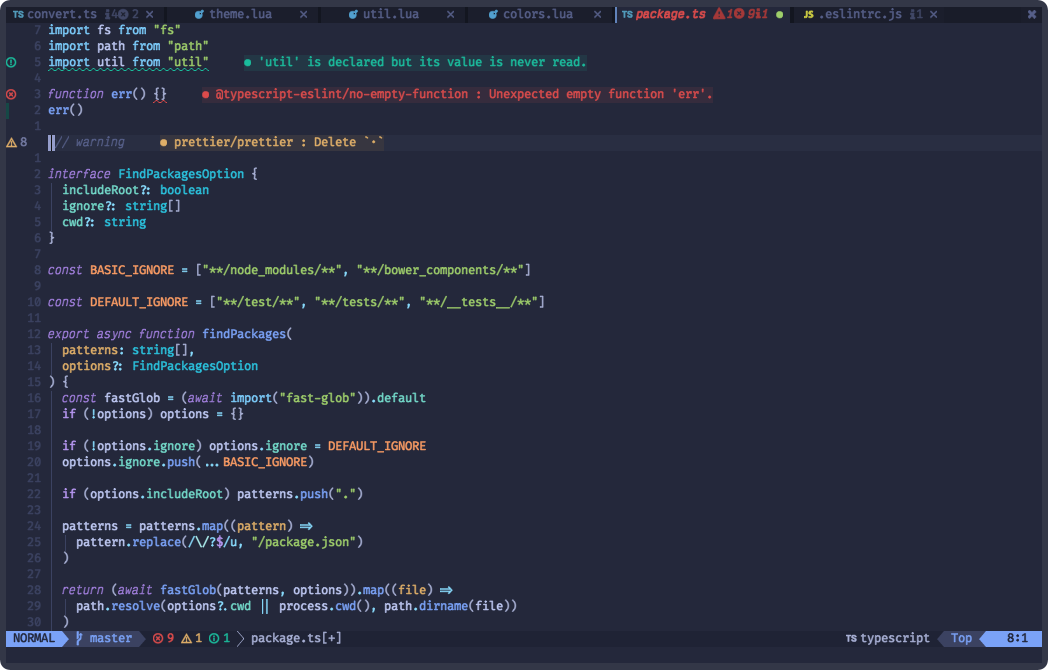A dark and light Neovim theme written in Lua ported from the Visual Studio Code TokyoNight theme. Includes extra themes for Kitty, Alacritty, iTerm and Fish.
- supports the latest Neovim 5.0 features like TreeSitter and LSP
- minimal inactive statusline
- vim terminal colors
- darker background for sidebar-like windows
- color configs for Kitty, Alacritty and Fish Shell
- lualine theme
- TreeSitter
- LSP Diagnostics
- LSP Trouble
- LSP Saga
- Git Signs
- Git Gutter
- Telescope
- NvimTree
- WhichKey
- Indent Blankline
- Dashboard
- BufferLine
- Lualine
- Lightline
- Neogit
- vim-sneak
- Fern
- Barbar
- Scrollbar
- Mini
- Neovim >= 0.6.0
Install the theme with your preferred package manager:
Plug 'folke/tokyonight.nvim', { 'branch': 'main' }use 'folke/tokyonight.nvim'Enable the colorscheme:
" Vim Script
colorscheme tokyonight
" There are also colorschemes for the different styles
colorscheme tokyonight-night
colorscheme tokyonight-storm
colorscheme tokyonight-day
colorscheme tokyonight-moon-- Lua
vim.cmd[[colorscheme tokyonight]]To enable the TokyoNight theme for Lualine, simply specify it in your
lualine settings:
require('lualine').setup {
options = {
-- ... your lualine config
theme = 'tokyonight'
-- ... your lualine config
}
}To enable the tokyonight colorscheme for Lightline:
" Vim Script
let g:lightline = {'colorscheme': 'tokyonight'}❗️ configuration needs to be set BEFORE loading the color scheme with
colorscheme tokyonight
The theme comes in four styles, storm, moon, a darker variant night and day.
The day style will be used if:
{ style = "day"}was passed tosetup(options)- or
vim.o.background = "light"
TokyoNight will use the default options, unless you call setup.
require("tokyonight").setup({
-- your configuration comes here
-- or leave it empty to use the default settings
style = "storm", -- The theme comes in three styles, `storm`, `moon`, a darker variant `night` and `day`
transparent = false, -- Enable this to disable setting the background color
terminal_colors = true, -- Configure the colors used when opening a `:terminal` in Neovim
styles = {
-- Style to be applied to different syntax groups
-- Value is any valid attr-list value for `:help nvim_set_hl`
comments = { italic = true },
keywords = { italic = true },
functions = {},
variables = {},
-- Background styles. Can be "dark", "transparent" or "normal"
sidebars = "dark", -- style for sidebars, see below
floats = "dark", -- style for floating windows
},
sidebars = { "qf", "help" }, -- Set a darker background on sidebar-like windows. For example: `["qf", "vista_kind", "terminal", "packer"]`
day_brightness = 0.3, -- Adjusts the brightness of the colors of the **Day** style. Number between 0 and 1, from dull to vibrant colors
hide_inactive_statusline = false, -- Enabling this option, will hide inactive statuslines and replace them with a thin border instead. Should work with the standard **StatusLine** and **LuaLine**.
dim_inactive = false, -- dims inactive windows
lualine_bold = false, -- When `true`, section headers in the lualine theme will be bold
--- You can override specific color groups to use other groups or a hex color
--- function will be called with a ColorScheme table
---@param colors ColorScheme
on_colors = function(colors) end,
--- You can override specific highlights to use other groups or a hex color
--- function will be called with a Highlights and ColorScheme table
---@param highlights Highlights
---@param colors ColorScheme
on_highlights = function(highlights, colors) end,
})How the highlight groups are calculated:
- the colors for the style are calculated based on your config
config.on_colors(colors)is ran, where you can override the colors- the colors are then used to generate the highlight groups
config.on_highlights(highlights, colors)is ran, where you can overide the highlight groups
Please refer to default values for colors and highlights for the storm, moon, night, day
Example for changing some settings and colors
require("tokyonight").setup({
-- use the night style
style = "night",
-- disable italic for functions
styles = {
functions = {}
},
sidebars = { "qf", "vista_kind", "terminal", "packer" },
-- Change the "hint" color to the "orange" color, and make the "error" color bright red
on_colors = function(colors)
colors.hint = colors.orange
colors.error = "#ff0000"
end
})Example to make Telescope borderless
require("tokyonight").setup({
on_highlights = function(hl, c)
local prompt = "#2d3149"
hl.TelescopeNormal = {
bg = c.bg_dark,
fg = c.fg_dark,
}
hl.TelescopeBorder = {
bg = c.bg_dark,
fg = c.bg_dark,
}
hl.TelescopePromptNormal = {
bg = prompt,
}
hl.TelescopePromptBorder = {
bg = prompt,
fg = prompt,
}
hl.TelescopePromptTitle = {
bg = prompt,
fg = prompt,
}
hl.TelescopePreviewTitle = {
bg = c.bg_dark,
fg = c.bg_dark,
}
hl.TelescopeResultsTitle = {
bg = c.bg_dark,
fg = c.bg_dark,
}
end,
})To have undercurls show up and in color, add the following to your Tmux config file:
# Undercurl
set -g default-terminal "${TERM}"
set -as terminal-overrides ',*:Smulx=\E[4::%p1%dm' # undercurl support
set -as terminal-overrides ',*:Setulc=\E[58::2::%p1%{65536}%/%d::%p1%{256}%/%{255}%&%d::%p1%{255}%&%d%;m' # underscore colours - needs tmux-3.0Extra color configs for Kitty, Alacritty, Fish, WezTerm, iTerm and foot can be found in extras. To use them, refer to their respective documentation.
You can easily use the color palette for other plugins inside your Neovim config:
local colors = require("tokyonight.colors").setup() -- pass in any of the config options as explained above
local util = require("tokyonight.util")
aplugin.background = colors.bg_dark
aplugin.my_error = util.brighten(colors.red1, 0.3)Pull requests are welcome. For the extras, we use a simple template system
that can be used to generate themes for the different styles.
How to add a new extra template:
- create a file like
lua/tokyonight/extra/cool-app.lua - add the name and output file extension to the
extrastable inlua/tokyonight/extra/init.lua - in Nvim, run
:lua require("tokyonight.extra").setup()to generate / update extra themes - commit the newly created themes under
extra/




